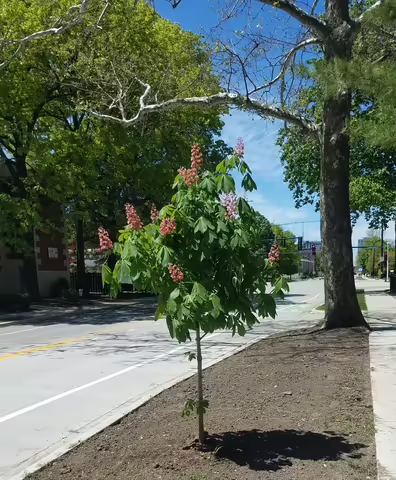The benefits of green space in urban areas has long been documented to improve our lives in a wide variety of ways. However, recent research has Illuminated the special role that trees and larger woody plants serve in our communities. Beyond ecological and environment benefits, these extremely valuable landscape plants have been shown to improve our mental health in amazing ways. As researchers work to further explore the fascinating relationship between trees and humans, the importance of woody plants in proximity to schools is becoming more apparent.
"Greenness" Around Schools Increases Academic Performance
In 2014, researchers in Massachusetts compared academic performance among 3rd graders to the relative “greenness” surrounding schools in 905 school districts across the state. Using satellite imagery, greenness was estimated within circular buffers up to 2000 meters wide around each school. Both trees and other green vegetation were included in greenness estimates for this research. At all buffer distances assessed, academic performance was improved in areas with greater greenness. These results indicated that communities with a higher density of green plants within 2000 meters (or a little over a mile) of schools reported higher math and English scores among 3rd graders.
Trees vs. Grass on Campus
Research at 101 southeastern Michigan High Schools explored the relationship between academic performance of students and the landscapes surrounding schools. Researchers assessed whether the presence of trees and shrubs were beneficial to academic performance when compared to less natural settings. To do this, they classified school campus landscapes based on the abundance of trees and shrubs versus areas of mowed grass or built environments and compared student academic performance across these campuses.
Researchers visited each campus and measured tree cover and other attributes of school campuses, along with other factors such as school building window sizes and views of nature available from classrooms and cafeterias. Findings indicate that school landscapes with more trees and shrubs were associated with higher academic performance when compared to campuses with fewer trees and more grass and parking lots.
However, academic performance was not shown to be enhanced when more trees and shrubs were visible from school windows. This implies that tree plantings on school campuses aren’t necessarily more effective if designed to be viewed from classrooms, leaving school administrators more flexibility in planting locations when adding woody plants to the landscape.
Featureless Landscapes have Negative Effects
In a study of 219 Washington DC school districts, a similar relationship was revealed when landscape attributes were compared to scores in mathematics and reading on standardized tests. For this effort, researchers used a detailed digital map of Washington DC which was categorized into various features on the landscape, from tree cover and grass cover to the presence of paved surfaces, bare soil, water and other features. Standardized test scores for students in grade 2-10 were then compared to assess the impact of landscape features on student performance.
As with other studies, this research found that schools with more trees within the boundaries of their campuses housed students with higher scores on standardized tests. School campuses with larger amounts of “featureless landscapes”, defined by the researchers as landscapes with larger areas of mowed lawns, athletic fields and other open spaces, were not as beneficial to students. In fact, featureless campuses were found to have a negative effect on student academic performance.
Other research on landscape preferences of adults has consistently shown that flat, grass-filled landscapes, which lack trees and shrubs, are considerably less appealing aesthetically when compared to more natural settings that include woody plants.
Trees and shrubs are incredibly beneficial to our communities and remain one the most important pieces of green infrastructure we can maintaining and enhance for of all. By adding trees to school campuses, future generations can be exposed to these spectacular plants and benefit from the many ways they enhance our lives.
References:
Kweon et al. 2017. The link between school performance and student academic performance. Urban Forestry and Urban Greening. 23: 35-43
Matsuoka, RH. 2010. Student performance and high school landscapes: examining the links. Landscape and Urban Planning. 97: 273-282.
Wu et al. 2014. Linking student performance in Massachusetts elementary schools with the “greenness” of school surroundings using remote sensing. PLOS One. 9(10): e108548.
